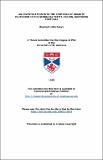Files in this item
An investigation into the controls of granite plutonism in the Sierra da Freita region, Northern Portugal
Item metadata
| dc.contributor.author | Reavy, Reginald John | |
| dc.coverage.spatial | 210p, 90p of plates. | en_US |
| dc.date.accessioned | 2012-07-12T14:58:27Z | |
| dc.date.available | 2012-07-12T14:58:27Z | |
| dc.date.issued | 1988 | |
| dc.identifier.uri | https://hdl.handle.net/10023/2973 | |
| dc.description.abstract | The Serra da Freita region of north central Portugal was chosen for study as it displays the complex relationships between regional structure, plutonism, regional and contact metamorphism typical of this part of Iberia. The region was mapped on a scale of 1:10000. The Serra da Freita pluton, which intrudes the core of the Porto-Viseu metamorphic belt developed in the late Pre-Cambrian - Cambrian Beira Schists, is shown to lie in a sinistral transpressive shear zone, the Serra da Freita shear zone. Early structures are progressively modified over a protracted period by shear zone deformation, during which time metamorphism reached a peak and the granite was emplaced. Mapping of the intrusive contacts of the granite show that following initial intrusion of a steeply inclined sheet of magma into the zone of highest strain, magmas were injected into a region of progressively lower strain where the magma was acconunodated as a nearly flat sheet. The distal end of this mass ballooned upvards to form the small intrusion of Castanheira which has abundant biotite nodules which acted as near perfect strain markers. The main pluton is shown to intrude obliquely the core of a narrow metamorphic belt characterized by parageneses of biotite, andalusite/staurolite, sillimanite, which maps distinctly from a younger cordierite sillimanite contact aureole around an adjacent quartz diorite body. Several facies of granite within the pluton have been recognized; petrographical and structural studies allow the interpreted emplacemen~ mechanism of these units to be integrated within a more general model for the evolution of the shear zone. Geochemical analyses of major and trace elements show that certain compositional trends within these facies cannot be simply related as part of a fractionation sequence. A model is put forward in which repeated melting of a heterogeneous source is followed by sequential emplacement of discrete batches of magma as sheets and wedges wi thin the acti ve shear zone. A Rb-Sr whole rock isochron age of 324 Ma was obtained and this dates not only the emplacement age of the syn-tectonic granite, but also constrains the time of movement along the shear zone. Radiogenic and stable isotope data strongly point to the local high grade Beira Schists as being sui table source rocks for generation of magmas wi th marked S-type characteristics which now form the Serra da Freita pluton. 180 values for the granites of 10.64 ± 0.24 - 13.00 ± 0.12 overlap those of the schists which lie in the range 12.38 ± 0.24 - 14.15 ± 0.4. The whole rock Rb-Sr isochron for the granite has an initial ratio of 0.7136 ± 0.0008 (MSWD = 3.2). A regional and tectonothennal model is put forward in which end-Palaeozoic oblique strike slip collision took place in the Ibero-Armorican Arc. The resulting peturbation in continental heat flow, coupled with the possible effects of shear heating, fluid concentration and local high ductility contrasts in the heterogeneous metasediments, are invoked as being responsible for causing anatexis of the Beira Schists at a depth of 10-12 km, and the generation of granitic melts. Emplacement of these bodies gave rise to the Porto-Viseu metamorphic belt, into which later smaller higher-level melts were injected. It is argued that some of these later magmas which reached higher levels are now exposed as the constituent facies of the Serra da Freita pluton. The Serra cia Freita shear zone, active throughout metamorphism, anatexis and magma emplacement was a dominant feature of the geological history of the region. | en_US |
| dc.language.iso | en | en_US |
| dc.publisher | University of St Andrews | |
| dc.subject.lcc | QE462.G7R3 | |
| dc.subject.lcsh | Granite | en_US |
| dc.title | An investigation into the controls of granite plutonism in the Sierra da Freita region, Northern Portugal | en_US |
| dc.type | Thesis | en_US |
| dc.type.qualificationlevel | Doctoral | en_US |
| dc.type.qualificationname | PhD Doctor of Philosophy | en_US |
| dc.publisher.institution | The University of St Andrews | en_US |
This item appears in the following Collection(s)
Items in the St Andrews Research Repository are protected by copyright, with all rights reserved, unless otherwise indicated.

